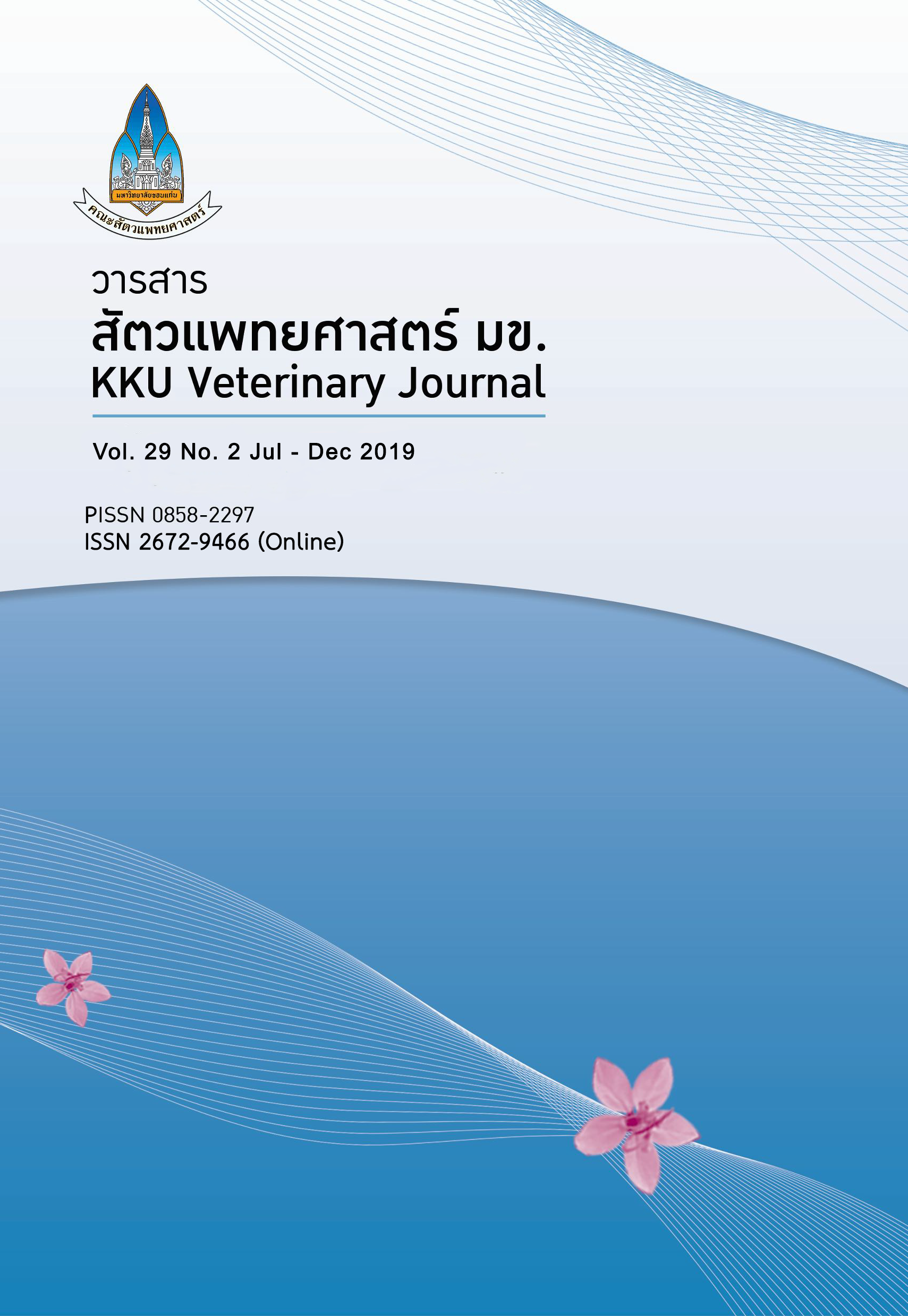Comparison of Salmonella spp. Contamination and Antimicrobial Resistance Patterns between Two Pig Slaughterhouse Models
Main Article Content
บทคัดย่อ
Objective: To compare the Salmonella spp. contamination and antimicrobial resistance (AMR) patterns between two pig slaughterhouse models,
Materials and Methods: Three hundred sixty pig fecal samples and 360 pork samples were collected from one Hazard Analysis and Critical Control Point (HACCP) standard slaughterhouse and one poor hygiene practice (PHP) slaughterhouse (180 pig fecal samples and 180 pork samples were collected from each slaughterhouse) in Khon Kaen province during 2017-2018 (n=720). All samples were purified and serotype identified. The positive Salmonella spp. isolates were then tested for their antimicrobial susceptibility against ampicillin, ciprofloxacin, chloramphenicol, nalidixic acid, streptomycin, sulfamethoxazole-trimethoprim, tetracycline, and colistin. Results: There were 230 Salmonella spp. isolates purified from the total of samples (n=720); 39.17% Salmonella spp. were isolated from pig fecal samples (141/360) and 24.72% from pork (89/360). The fecal and pork isolates from the HACCP slaughterhouse were 30.56% (110/360) and 6.39% (23/360), whereas the fecal and pork isolates from PHP slaughterhouse were 8.61% (31/360) and 18.33% (66/360), respectively. The most predominant serotype was the Enterica type I 4,[5],12:i:-.
Conclusion: After the statistical analyzed between two slaughterhouses, the results demonstrated that the HACCP standard slaughterhouse could reduce the proportion of serotype numbers of Salmonella spp., and stop some AMR spreading from pigs to pork, but the PHP slaughterhouse increased the proportion of positive Salmonella and serotype numbers from pigs to pork.
Article Details
เอกสารอ้างอิง
Alexander, T.W., Inglis, G.D., Yanke, L.J., Topp, E., Read, R.R., Reuter, T., McAllister, T.A. 2010. Farm-to-fork characterization of Escherichia coli associated with feedlot cattle with a known history of antimicrobial use. International Journal of Food Microbiology 137(1), 40-48.
Angkititrakul, S., Chomvarin, C., Chaita, T., Kanistanon, K., Waethewutajarn, S. 2005. Epidemiology of antimicrobial resistance in Salmonella isolated from pork, chicken meat and humans in Thailand. The Southeast Asian Journal of Tropical Medicine and Public Health 36(6), 1510-1515.
Chotinun, S., Rojanasthien, S., Unger, F., Tadee, P., Patchanee, P. 2014. Prevalence and antimicrobial resistance of Salmonella isolated from carcasses, processing facilities and the environment surrounding small scale poultry slaughterhouses in thailand. The Southeast Asian Journal of Tropical Medicine and Public Health 45(6), 1392-1400.
CLSI, 2014. Performance standard for antimicrobial susceptibility testing twenty-fourth informational supplement.
EFSA, ECDC. 2017. The European Union summary report on trends and sources of zoonoses, zoonotic agents and food-borne outbreaks in 2016. European Food Safety Authority Journal, 15(12).
EFSA. 2018. The European Union summary report on trends and sources of zoonoses, zoonotic agents and food‐borne outbreaks in 2017. . European Food Safety Authority Journal, 16(12).
Fasanmi, O.G., Makinde, G.E.O., Popoola, M.A., Fasina, O.F., Matere, J., Ogundare, S.T. 2018. Potential risk factors associated with carcass contamination in slaughterhouse operations and hygiene in Oyo state, Nigeria. International Journal of Livestock Production 9(8), 211-220.
Gillespie, I.A., O'Brien, S.J., Adak, G.K., Ward, L.R. Smith, H.R., 2005. Foodborne general outbreaks of Salmonella Enteritidis phage type 4 infection, England and Wales, 1992-2002: where are the risks? Epidemiology and Infection 133(5), 795-801.
Grimont P.A., Weill, F.X. 2007. Antigenic formulae of the Salmonella serovars. WHO collaborating center for reference and research on Salmonella 2007; 9: 1-166.
Hendriksen, R.S., Bangtrakulnonth, A., Pulsrikarn, C., Pornruangwong, S., Noppornphan, G., Emborg, H. D., Aarestrup, F. M. 2009. Risk factors and epidemiology of the ten most common Salmonella serotypes from patients in Thailand: 2002-2007. Foodborne Pathogens and Disease 6(8), 1009-1019.
Hummel, R., Tschape, H., Witte, W. 1986. Spread of plasmid-mediated nourseothricin resistance due to antibiotic use in animal husbandry. Journal of Basic Microbiology 26(8), 461-466.
Knoblauch, A.M., Bratschi, M.W., Zuske, M.K., Althaus, D., Stephan, R., Hachler, H., Kiefer, S. 2015. Cross-border outbreak of Salmonella enterica ssp. enterica serotype Bovismorbificans: multiple approaches for an outbreak investigation in Germany and Switzerland. Swiss Medical Weekly 145, w14182.
Landers, T.F., Cohen, B., Wittum, T.E., Larson, E.L. 2012. A review of antibiotic use in food animals: perspective, policy, and potential. Public Health Reports 127(1), 4-22.
ISO. 2002. Microbiology of food and animal feeding stuffs - Horizontal method for the detection of Salmonella spp. (Vol. ISO 6579 : 2002 (E)). Switzerland, Geneva.
McCrackin, M.A., Helke, K.L., Galloway, A.M., Poole, A.Z., Salgado, C.D., Marriott, B.P. 2016. Effect of antimicrobial use in agricultural animals on drug-resistant foodborne Campylobacteriosis in humans: a systematic literature review. Critical Reviews in Food Science and Nutrition 56(13), 2115-2132.
Patchanee, P., Tansiricharoenkul, K., Buawiratlert, T., Wiratsudakul, A., Angchokchatchawal, K., Yamsakul, P., Tadee, P. 2016. Salmonella in pork retail outlets and dissemination of its pulsotypes through pig production chain in Chiang Mai and surrounding areas, Thailand. Preventive Veterinary Medicine 130, 99-105.
Van, T.T., Chin, J., Chapman, T., Tran, L.T., Coloe, P.J. 2008. Safety of raw meat and shellfish in Vietnam: an analysis of Escherichia coli isolations for antibiotic resistance and virulence genes. International Journal of Food Microbiology 124(3), 217-223.
Wilhelm, B., Rajic, A., Greig, J.D., Waddell, L., Harris, J. 2011. The effect of hazard analysis critical control point programs on microbial contamination of carcasses in slaughterhouses: a systematic review of published data. Foodborne Pathogens and Disease 8(9), 949-960.


